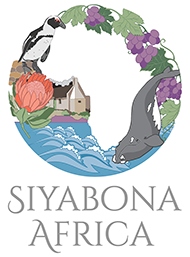The last few hundred years have seen considerable speculation for precious metals on Table Mountain. Several remnants of these quests for treasure can still be found scattered on the slopes of Devil's Peak, Chapman's Peak and at the Silvermine Nature Reserve. ©Photo: Shaen Adey ©Siyabona Africa recommended book on Table Mountain:
©Photo: Shaen Adey ©Siyabona Africa recommended book on Table Mountain:
Table Mountain Activities
Authors: Shaen Adey and Fiona McIntosh.
Copyright © 2004 Struik Publishers Cape Town.
If you return to the main path and up the zigzags in the direction of Constantia Nek, you'll come across several more dumps and evidence of manganese extraction but, to be honest, you'll find the walk more interesting than the mine dumps themselves.
Words by Fiona McIntosh
Photographs by Shaen Adey

Table Mountain Activities
Authors: Shaen Adey and Fiona McIntosh.
Copyright © 2004 Struik Publishers Cape Town.
Gold
The best known treasure-hunting period was the brief nineteenth century gold rush that followed the announcement by Captain Glendinnings' that he had found gold on his property at Camps Bay. In 1887 The Lion's Head Gold Syndicate dug several shafts to extract rock, which, with much anticipation, was taken to Wilkinson's Mill in Kloof Street where it was crushed and assayed. Small quantities of gold were extracted but the project quickly proved to be uneconomical.In 1891 the Cape Town Public Works Committee decided that the open shaft on Lion's Head was a source of danger and instructed the Gold Syndicate to fill it in or fence it off. A year later the land was sold and Cape Town's prominent landmark left unscathed. I have searched the slopes above Fresnaye around the neck between Lion's Head and Signal Hill but have never found remains of the shaft (which was apparently bulldozed in the 1950s to avoid accident) so good luck if you seek to verify this!Tin
The remains of the old tin mine on Devil's Peak are more interesting, though the mine itself - opened in 1912 - was shortlived. Photographs show a major shaft out of which the Vredehoek Tin Company extracted tin from crushed ore. Flat terraces and concrete foundations, a small earthwork dam and various other concrete structures are still visible on Prospect Hill, accessible from St James Road in Vredehoek.Manganese
If you wish to go exploring, the manganese mine near the East Fort on Chapman's Peak Drive is possibly the most interesting of the treasure-hunting sites. The mine is also marked on most maps of the mountain. Manganese was discovered in the Constantiaberg area in 1873 and was then mined in Hout Bay between 1909 and 1911. The ruins of the manganese ore jetty, where the ore was loaded up after being sent down from the mine on a chute, are easily visible on the east side of the bay beneath the shafts.Park your car at the parking area on the left-hand side just beyond East Fort - a couple of hundred metres before the toll plaza - and take the old gravel forestry road up the hill in the direction of Hout Bay. A cairn that's about 150m (492ft) beyond the first bend will take you up to a series of zigzags. Follow the path until, after a bend to the left, it divides. Take the lower path, which is blocked by a line of stones and continue along a terrace to a hole in the fence. Once through the fence you will see evidence of old mine heaps.Continue over these until you see an obvious gash in the cliffs on the right. This is the most impressive of the numerous mine shafts in the vicinity and you will see old timbers and the remains of the corrugated iron high above you. The shaft itself is not deep and the entrance is adorned with beautiful ferns. If you have any energy left you can scramble up the hill to explore other mine shafts, but take note that these are even more inaccessible.If you return to the main path and up the zigzags in the direction of Constantia Nek, you'll come across several more dumps and evidence of manganese extraction but, to be honest, you'll find the walk more interesting than the mine dumps themselves.

